Following in the footsteps of its company-wide commitment to electric vehicles, Stellantis filed an application with the United States Patent and Trademark Office (USPTO) in late January that hints at the name of its forthcoming electric truck: Ram Revolution. Covering motor vehicles in the passenger truck segment, it offered no design hints, with no indications of fonts or logos.
Furthermore, a recent presentation spotlighting the planet-protective plans of Stellantis offered very little specific information on this environmentally-friendly truck, as a key player in its overall EV strategy. By playing its cards close to the chest, Stellantis leaves its production and marketing options wide open and fully flexible.
Global Leader Goes Green
The outcome of a 2021 merger between France’s Groupe PSA (Peugeot, Citroen etc.) and the Italian-American FCA (Fiat-Chrysler Automobiles) conglomerate, Stellantis plans to invest well over CAD 40 billion (€30 billion) in going electric by 2025. Its sales targets for low-emission vehicles are set at 70% in Europe and 40% in the USA by the end of this decade.
With each of its fourteen marques expected to offer at least one fully electric vehicle, these green ambitions are spotlighted by snappy taglines that are specific to each brand. Aligned with the Chrysler tagline of Clean Technology for a New Generation of Families and Dodge’s Tear Up the Streets…Not the Planet, Ram’s EV slogan is: Built to Serve a Sustainable Planet.
Plug-In Pickups Forging Ahead
With the entire auto industry rushing to offer plug-in models, Ram must naturally follow suit. However, with production expected to start up only in 2024, the all-electric Ram 1500 is lagging behind some of its rivals.
For instance, Canadian dealerships will be selling Toyota’s all-electric bZ4X by mid-2022, with its Tundra offering a hybrid powertrain. Chevrolet’s Silverado may start up production of an electric version in 2023, while Ford is already accepting orders for its F150 Lightning.
Ram EV Predictions
Although merely filing a trademark is no guarantee that a vehicle will ever hit the highway, Stellantis has dropped a few intriguing hints. Chances are high that this electric pickup will ride on some version of the new Stella (STLA) frame.
With a steady stream of electric vehicles planned for the brands within its global portfolio, the Stellantis electrification strategy is focused on developing technologies that can be cross-shared across brands. With affordability a top priority, this conglomerate is aiming at bringing total EV ownership costs down to levels equivalent to traditional internal combustion engines by 2026.
Ensuring EV Affordability
Launched at the Stellantis EV Day in 2021, the Stella (STLA) platform is an important aspect of its cost-pruning strategies. Deliberately modular, its architecture can handle vehicles of many different sizes. So far, four versions have been planned, three unibody and one a body-on-frame structure designed for large commercial vehicles and heavy pick-up trucks:
- STLA Small for ultra-compact city cars with a range of up to 500 kms;
- STLA Medium for compact cars with a range of up to 700 kms;
- STLA Large for vehicles for off-roaders, crossovers, and muscle cars with a range of up to 800 kms
- STLA Frame with a similar capacity but holding battery packs of 159 to over 200 kWh. This is the body-on-frame solution that will be used for the fully electric Ram 1500.
Joint Software Development
Software written for vehicles built on the Stella platform will be updated continuously, for better functionality. From in-vehicle collectivity to infotainment, cloud service platforms and telematics, Stellantis will be working with Foxconn, through their Mobile Drive joint venture.
There’s little doubt that the Ram Revolution will benefit from technologies underpinned by the engineering expertise of Stellantis and Foxconn’s hardware and software development track record.
